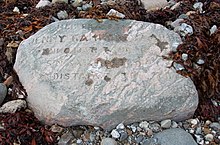Gniben
Gniben is the outermost point of the Danish peninsula Sjællands Odde , which protrudes 15 kilometers into the Kattegat from the peninsula Odsherred belonging to the island of Zealand . The Gniben is also the most north-westerly point of the municipality of Odsherred .
location
The name Gniben translated means steep mountain . In fact, the Gniben is formed by a small ridge that drops steeply towards the water. On the hill there is an artillery school of the Danish Navy. Nevertheless, the Gniben is accessible to the public on foot from a parking lot not far from the outermost point. However, access will be blocked during target practice. Below sea level, the ridge extends even further into the Kattegat as the reef Sjællands Rev. The reef is marked by a lighthouse eight kilometers north-west of the Gnibens . Various wrecks from ships that have sunk on the reef lie along the reef .
In the vicinity of the coast of the peninsula there are also remains of several settlements from the Stone Age between 9000 and 5000 before the beginning of our era. At this point in time, the sea level was significantly lower. Somewhat east of Gnibens on the north coast of the peninsula there are walls and hollows that are temporarily filled with water, which were created by the extraction of sand, stones and gravel. This as Topperne designated landscape today is habitat for marsh frogs , newts , newts and toads . In the flora, common hawthorn , blackthorn , dog rose and broom should be mentioned.
history
Originally the Gniben was the outermost of three offshore islands. Due to the accumulation of gravel and sand, a land connection was created between the islands and Zealand.
In the 1930s, swimming events on the Gniben caused a sensation. In 1937 and 1938 people swam from here through the Kattegat to Jutland . On August 6, 1938, Edmund Olsen swam from Gniben to Kobberød in 18 hours and 25 minutes . The sensation associated with the swimming events meant that the building closest to Gniben was converted into a summer hotel with a restaurant in 1938. The stones lying on the shoreline are reminiscent of the Kattegat swimmers, bearing the names and details of the swimmers.
After the occupation of Denmark by German troops in the course of the Second World War , the Gniben was confiscated by the German Navy in May 1940. A coastal battery was created. Cannons from the former Danish coastal armored ship Herluf Trolle were used to arm the battery . After the end of the war and the withdrawal of German units, the facility was nationalized and has since been used by the Danish Navy as an artillery school.
Another Kattegat swim took place on August 12, 2010. The five swimmers Bo Stenhuus, Peter Schultz, Ann Sophie Claire Lønnberg, Tue Vejsager Nøddekær and Jacob Clement Nielsen conquered the route from Gniben to Elsegårde in 13 hours and 32 minutes . A stone on the beach also reminds of these swimmers.
literature
- Odsherred, Oplevelser mellem Lammefjord, Sjællands Odde og Rørvig , Nykøbing Sjælland, 2013, page 14
Web links
Coordinates: 56 ° 0 ′ 38.1 ″ N , 11 ° 16 ′ 39.4 ″ E




